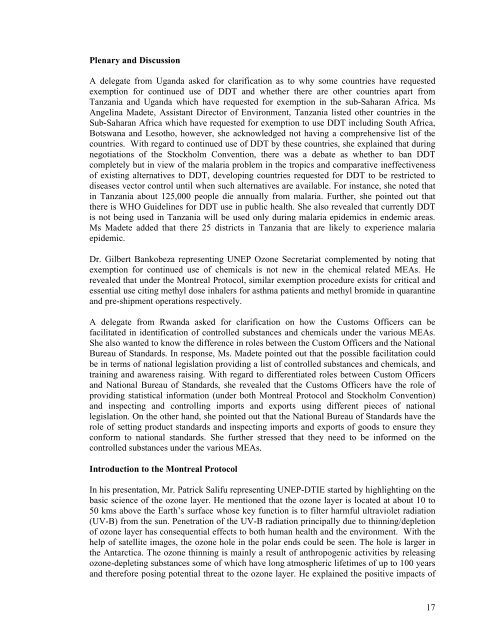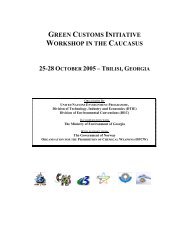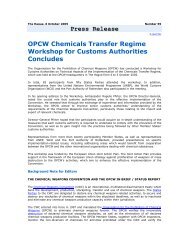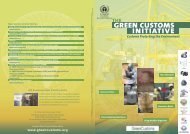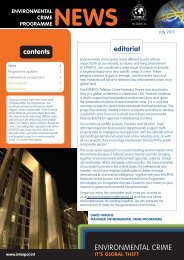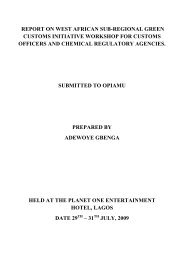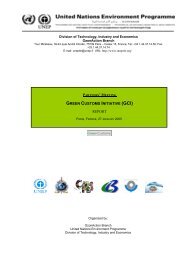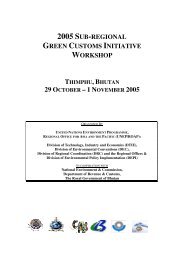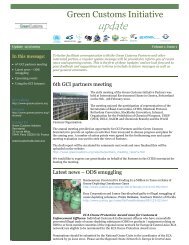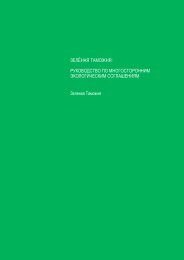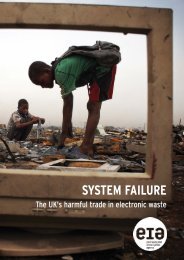Arusha - Green Customs Initiative
Arusha - Green Customs Initiative
Arusha - Green Customs Initiative
You also want an ePaper? Increase the reach of your titles
YUMPU automatically turns print PDFs into web optimized ePapers that Google loves.
Plenary and Discussion<br />
A delegate from Uganda asked for clarification as to why some countries have requested<br />
exemption for continued use of DDT and whether there are other countries apart from<br />
Tanzania and Uganda which have requested for exemption in the sub-Saharan Africa. Ms<br />
Angelina Madete, Assistant Director of Environment, Tanzania listed other countries in the<br />
Sub-Saharan Africa which have requested for exemption to use DDT including South Africa,<br />
Botswana and Lesotho, however, she acknowledged not having a comprehensive list of the<br />
countries. With regard to continued use of DDT by these countries, she explained that during<br />
negotiations of the Stockholm Convention, there was a debate as whether to ban DDT<br />
completely but in view of the malaria problem in the tropics and comparative ineffectiveness<br />
of existing alternatives to DDT, developing countries requested for DDT to be restricted to<br />
diseases vector control until when such alternatives are available. For instance, she noted that<br />
in Tanzania about 125,000 people die annually from malaria. Further, she pointed out that<br />
there is WHO Guidelines for DDT use in public health. She also revealed that currently DDT<br />
is not being used in Tanzania will be used only during malaria epidemics in endemic areas.<br />
Ms Madete added that there 25 districts in Tanzania that are likely to experience malaria<br />
epidemic.<br />
Dr. Gilbert Bankobeza representing UNEP Ozone Secretariat complemented by noting that<br />
exemption for continued use of chemicals is not new in the chemical related MEAs. He<br />
revealed that under the Montreal Protocol, similar exemption procedure exists for critical and<br />
essential use citing methyl dose inhalers for asthma patients and methyl bromide in quarantine<br />
and pre-shipment operations respectively.<br />
A delegate from Rwanda asked for clarification on how the <strong>Customs</strong> Officers can be<br />
facilitated in identification of controlled substances and chemicals under the various MEAs.<br />
She also wanted to know the difference in roles between the Custom Officers and the National<br />
Bureau of Standards. In response, Ms. Madete pointed out that the possible facilitation could<br />
be in terms of national legislation providing a list of controlled substances and chemicals, and<br />
training and awareness raising. With regard to differentiated roles between Custom Officers<br />
and National Bureau of Standards, she revealed that the <strong>Customs</strong> Officers have the role of<br />
providing statistical information (under both Montreal Protocol and Stockholm Convention)<br />
and inspecting and controlling imports and exports using different pieces of national<br />
legislation. On the other hand, she pointed out that the National Bureau of Standards have the<br />
role of setting product standards and inspecting imports and exports of goods to ensure they<br />
conform to national standards. She further stressed that they need to be informed on the<br />
controlled substances under the various MEAs.<br />
Introduction to the Montreal Protocol<br />
In his presentation, Mr. Patrick Salifu representing UNEP-DTIE started by highlighting on the<br />
basic science of the ozone layer. He mentioned that the ozone layer is located at about 10 to<br />
50 kms above the Earth’s surface whose key function is to filter harmful ultraviolet radiation<br />
(UV-B) from the sun. Penetration of the UV-B radiation principally due to thinning/depletion<br />
of ozone layer has consequential effects to both human health and the environment. With the<br />
help of satellite images, the ozone hole in the polar ends could be seen. The hole is larger in<br />
the Antarctica. The ozone thinning is mainly a result of anthropogenic activities by releasing<br />
ozone-depleting substances some of which have long atmospheric lifetimes of up to 100 years<br />
and therefore posing potential threat to the ozone layer. He explained the positive impacts of<br />
17


